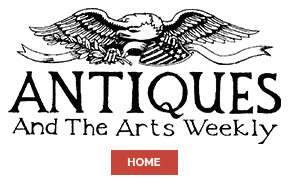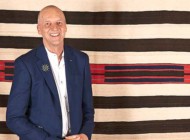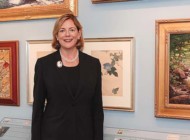
Grinnell with Stacy Tolman’s “Sydney Burleigh in his Studio.” Photo by Jason Beene.
Nancy Whipple Grinnell, curator emerita at the Newport Art Museum, has most recently been using her professional expertise to document the Providence Art Club’s paintings and archives. Founded in 1880, the Providence Art Club nurtured the core artists of the Providence School, who contributed to the vibrant Nineteenth and early Twentieth Century American art scene. While many outside of the locale may be unfamiliar with some of these artists, Grinnell is working to bring their works to light.
How did you first get involved with the Providence Art Club?
About 20 years ago, when I was in the middle of my career as curator at the Newport Art Museum, I was approached by board member Ted Mattis, also a board member at the Providence Art Club and chair of its Collections Committee. He asked me to join the Committee, which I did, finally becoming a member of the Club in 2015. In Newport, I had organized a small exhibition highlighting some of the Club’s important pieces. Subsequently, after my retirement in Newport, I took the helm of the Collections Committee at the Providence Art Club. The challenges of collecting, refining, researching and conserving were intriguing.
How has your professional experience led you to this archiving project?
I was originally an art librarian, with an MLS from Simmons University, and have always been inclined to provide access to archival information in the arts. Working in the magnificent collection of the Weyerhaeuser family at the Art Complex Museum in Duxbury (Mass.), I used an early custom database to catalog fine art from the collection, referencing archival sources in Carl Weyerhaeuser’s important library — back when books and not the internet provided important information! After arriving in Newport in 1998, I realized the untapped potential of the archives in the historic Art Association of Newport (now the Newport Art Museum) in relation to the collection of fine art. After 18 years as curator there, I brought my experience to other projects including the Providence Art Club.

Nancy with bronze bust of Edward M. Bannister, created by Gage Prentiss in 2020 as forerunner to the Bannister Community Art Project. Photo by Jason Beene.
Could you talk a bit about what goes into this documentation of work and archives?
Tedious to some, but not to me, cataloging the fine art collection involves examining each piece for artist, title, date, medium, dimensions, condition, signature, description, donor, provenance. That information is then entered into a database along with any relevant notes and an image. As there are over 600 art works in the collection — with about 200 on view in the Club — and I am a volunteer, this has taken a few years. Organizing paper archives according to the Society of American Archivist standards involves sorting chronologically into categories such as “printed material,” “correspondence,” “photographs,” etc. At the Art Club these categories are then broken down further by “collections/exhibitions,” “events/classes” and “administration.” They are filed in archival boxes; ideally there will be a finding aid. We also carefully maintain the archival scrapbooks, dating back to the founding. I have built on the earlier efforts of knowledgeable volunteers, as the Providence Art Club is not a museum and has always relied on volunteers to maintain its archives and collection.
Are you pulling resources and materials from other sources besides the Providence Art Club to aid in the process?
Yes, since its founding, the Providence Art Club has collaborated with other institutions, so I consult with the Rhode Island School of Design (RISD), the Rhode Island Historical Society, the Providence Athenaeum and the Providence Public Library, among others. The Art Club receives many inquiries about artists or works exhibited years ago, so I follow up by reaching out to others in the arts community. Sometimes relatives of historic artists have works or information that they share. And three of my former professors at Brown, where I later obtained an MA in American civilization/museum studies, are Providence Art Club members, and always helpful.
Besides yourself, is anyone else involved in this project?
Yes, the Collections Committee, which I chair, is very supportive and advises on accessions and de-accessions. Some of its members — who are also collectors — have amazing institutional memories which is helpful, as many of the works in the collection have no known provenance. Other committee members such as Claudia Iannuccelli, a conservator; Alice Tingley, a frame expert; Anthony Caffrey, an appraiser; and Jason Beene, an art director; bring their specific skills to the table. Former member Chris Ratcliffe was instrumental in putting the archives online. And Art Club member and gallery owner Catherine Bert is always insightful.

Nancy with George Barse’s “The Plaster Shop.” Photo by Jason Beene.
What are some of the most notable pieces you’re working with?
Of the historic male founders, I of course love the work of Edward M. Bannister, especially “The Old Home”; the “New England Landscape” by his colleague, George Whitaker; and a powerful portrait of the artist Elihu Vedder by Charles Walter Stetson. The Club has over 50 works by artist Sydney Burleigh, an important early member and designer of the Arts and Crafts Fleur de Lys building on campus. One of our treasure troves is a hand-crafted box of Burleigh’s sketchbooks of his travels in Europe in the 1880s. Some of the early artists portrayed the interiors of the club, such as Stacy Tolman’s “The Green Room” and his painting of Sydney Burleigh at work in his studio in the Fleur de Lys building.
As I have specialized in American women’s art history and was co-curator for “Making her Mark,” an exhibition of the Art Club’s women founders and early members, I hold a special affection for the art of Rosa Peckham, Helen Watson Phelps, Jane Nye Hammond and Emma Swan. The Club has a significant collection of art works by later important women artists and members Angela O’Leary, Eliza Draper Gardiner, Mabel Woodward and Grace Arnold Albee.
However, I appreciate equally the number of mid Twentieth Century works by lesser known but interesting Rhode Island artists and Art Club members such as John Frazier, Gordon Peers, Florence Leif, Pat Masiello, Bannigan Sullivan and Huseyin Halit. We even have pieces by Dale Chihuly, as he was and still is a member!

Founders’ Room with George Whitaker’s “New England Landscape” and William Cushing Loring’s “Charlie Harry.” Photo by Nancy Grinnell.
What is the end goal of this project?
We hope to make the membership and the community more aware and appreciative of the collection; to conserve and preserve it for the future. The board at the Club plans to cultivate its patron members who are eager to have more art historical experiences. To this end, we might do more specific art tours of the collection and perhaps eventually a publication. As most of the gallery space at the Club is devoted to member artists, we will investigate alternative ways to exhibit more of the collection. We also hope to make more of the archives available online.
Have you made any new discoveries or revelations in doing this work?
Yes, all the time, and here is where the archives come in. We have an interesting portrait of a Black man, painted by RISD professor and Art Club member William Cushing Loring, about 1917. The portrait, with a miniature image of Abraham Lincoln up in the top corner was exhibited in the past but was relegated to storage with a damaged frame when I discovered it. It is actually a portrait of the Art Club’s second steward (manager of the café), Charlie Harry, who worked from 1910 until the 1930s. There is considerable information on him in the archives. The frame was repaired, and the painting now hangs in the Founders Room where new audiences can appreciate it. Even the subject’s descendants have visited it.
The archives help to further identify art works: for instance the lovely figurative painting of a woman in a kimono, by Helen Wilson Phelps, was identified only as “Figure.” I discovered a letter from the artist’s sister noting that it was titled “The Purple Bowl,” exhibited in an important New York City gallery with other prominent artists and donated by the family after the artist’s death. Old exhibition catalogs help with titles and dates. Determining a work’s provenance is also sometimes made possible by citing the archives. Although it is frustrating when I find a copy of a letter from the 1950s to a donor which reads “Thank you for the four paintings…” but does not identify them!

Founders’ Room with bronze busts of Edward M. Bannister by Gage Prentiss and James Sullivan Lincoln by Adolfo Apolloni; in the cases are “Newsboy” and “The Purple Bowl” by Helen Watson Phelps. Photo by Jason Beene.
What does this project mean to you?
I love my work at the Providence Art Club; it is very rewarding to contribute in such a way at this late stage of my career! I enjoy my colleagues and the staff and hope that whoever follows will build upon my work, as I have built upon others. With an institution that is 145 years old, the generations come and go; therefore, it is important to acquaint the many new members with our rich history, which includes an important collection of fine art.
How will it contribute to a greater conversation around Nineteenth and Twentieth Century art as a whole, and Providence School artists more specifically?
Well, it already has and will, I hope, continue to do so, in the form of outside lectures, exhibitions and publications. I have used the Providence Art Club archives and collections to present lectures to Historic New England, the Newport Historical Society and Salve Regina University’s Circle of Scholars, among others. We produced a catalog for our “Making her Mark” exhibition which was recently requested by the Metropolitan Museum of Art. I have curated exhibitions on Providence Art Club artists Edward Bannister, George Whitaker and Mabel Woodward at the Gilbert Stuart Museum in Rhode Island — all of which generated articles in American Art Review. And my ongoing research on historic Newport artists is enriched by the connections between the Providence Art Club and the Art Association of Newport which shared artist members such as Elijah Baxter, William H. Drury and Dorothy Holt Manuel.
—Carly Timpson




